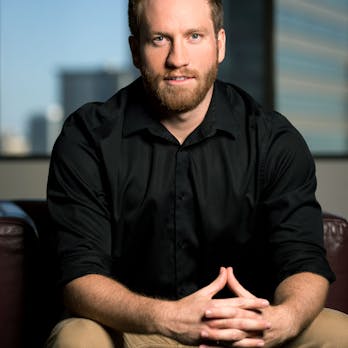

Get Access to 250+ Online Classes
Learn directly from the world’s top investors & entrepreneurs.
Get Started NowIn This Article
We all want to feel like a productive person. We dream about it. We imagine being unstoppable. We imagine being accomplished. We imagine wowing those around us—while things seem to happen effortlessly. But is our dream realistic, or is it just a fantasy?
Before you chase a golden goose, let’s pause to think about what it really means to be productive. This is the WealthFit definition of productivity:
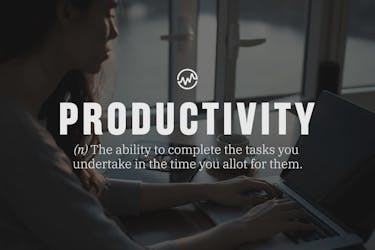
Pay close attention. There are 3 different parts to that definition. Let’s go over them one at a time.
The ability to complete . . . Productivity is finishing the tasks you start.
The tasks you undertake . . . Productivity is about choosing the tasks to undertake.
In the time you allot for them . . . Productivity is about finishing those tasks ON TIME.
Why is our definition important? Because our definition doesn’t change based on who reads it. You could be a monk or a CEO and it would be the same.
Most people consider a person who doesn’t do much lazy. But we see things differently.
Part of being productive is knowing what’s actually worth your time. A person who doesn’t do much is sometimes a productivity ninja without a mission.
Why do we feel this way? It all starts with understanding the economics of time.
The Economics of Time
When people think of economics, they think of money.
But at WealthFit, we define wealth as an abundance of money, time, and influence.
And really . . . your time is the most valuable asset you have.
Unlike cash, time flows in only one direction. You can’t create more of it and you’re certain to run out of it eventually. How you understand time has a huge impact on your productivity. When you realize how precious time is, you’re less likely to waste it.
To understand the significance of time, you first need an understanding of opportunity costs and transaction costs.
Opportunity Costs
An opportunity cost is the additional cost of any decision. When you choose to spend your time in one place, you are forfeiting the opportunity to spend it in another place. That lost opportunity is appropriately named the opportunity cost.
When people talk about opportunity costs, they’re usually talking about money. For example, if you spend $30K on a car today, you gain the car but you also lose the ability to invest the $30K you spent on the car. If instead you invested that $30K with a 3% annual return, you’d make $10K in 10 years. The investment you didn’t make, that $10K, is your opportunity cost.
A transaction cost is different . . .
Transaction Costs
A transaction cost is the price you pay to play. It’s the cost of any transaction (sale, task or decision)—built into the the transaction itself. Transaction costs are costs you don’t think of because they’re generally small compared to the actual transaction, but they add up over time.
Here’s a money example. You want to invest $5,000 in a stock market fund. Common sense would tell you to put your money in the fund that’s growing the fastest—but stock market funds change week to week. Does this mean you should move your money every week to the highest growth fund?
Of course not.
Every time you move your money, it takes time and costs fees. If you kept moving your money, you’d spend a fortune in fees. These fees are the transaction costs of investing in stock index funds. It’s the price you pay from the transactions themselves.
How does this apply to time? Because every . . .
- Task you work on
- Break you take
- Interruption
. . . has a transaction cost.
Every time you’re interrupted, the cost isn’t only the time it takes to address the interruption. The cost of an interruption includes the break in your flow. It takes time to get into the flow of a task. When that flow is broken, you have to start all over again.
This is why doing 5 things at once will get you nowhere. If you’re doing 5 things at once, most of your productivity is eaten up by the transaction time switching your focus between tasks.
Opportunity costs and transaction costs are key to understanding the importance of focus and prioritization.
How to Focus & Prioritize
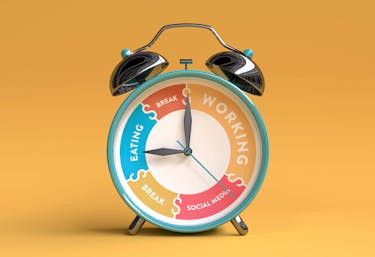
Understanding the value of your time is central to focusing and prioritizing.
Think about every time you’re interrupted in the course of a single day. When you’re knocked off course or pulled from a task, the cost isn’t just the time spent dealing with that interruption.
The cost of an interruption includes the break in your workflow and the time it takes to get back on track and back in the groove. If that flow is completely broken by an interruption, you could wind up starting from scratch—and that’s a major transaction cost.
Through that lens, it’s clear why multitasking isn’t always a good thing. Do five things at once—or try to do five things at once—and you’ll likely get nothing done since the bulk of your time will be eaten up as you switch focus from task to task.
Opportunity costs and transaction costs are important to weigh when you think about prioritization and focus. By prioritizing essential tasks and to-dos—and by staying completely focused on those tasks until they’re complete—you’ll be more productive from start to finish.
Never Multitask
In the 1990s multitasking was how you described a workaholic. When movies showed a busy business person they were always doing 5 things at once. That’s the narrative we learned about productive people: “if you want to be productive, you have to do lots of things at one time.”
But as it turns out, that’s not true at all.
Study after study shows successful people don’t multitask: they do the opposite. They focus on a single task with extreme intensity and ignore the temptation to do anything else.
So why do we multitask? Well, there’s two reasons. The first is that multitasking allows us to avoid the crucial but difficult things we should be working on. The second is that we haven’t prioritized right.
If it’s the second reason, if you feel overwhelmed by competing interests, take time to put them in order of priority.
Prioritization & Learning to Say “NO”
Priorities begin and end with knowing how—and when—to say no.
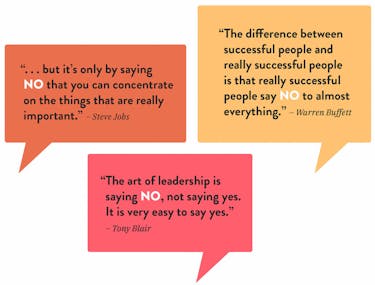
So many titans of industry believe in saying “no.”
Productivity begins with prioritizing and simplifying your workload. To be productive, you need to say no to everything that isn’t the most important thing for you to be working on in that exact moment.
One of the most common causes of unproductive behavior is saying “yes” to too many projects. Learning to say “no” is the first step to productivity.
When you say “no,” you’re saying “yes” to the things that DO matter. You’re simplifying your workload by eliminating the not-so-important tasks. It doesn’t mean you won’t return to them and it doesn’t mean they won’t be prioritized later, tomorrow or in a week from now.
It simply means that right now, you’re choosing to focus on something else so you can be more productive and more successful all around.
However, the challenge is that many of us struggle to say “no.”
Often, the people who get things done are often the ones who get tapped for the promotions, the opportunities and the corner offices. In our minds, they say “yes” and they excel—but, more often than not, that’s not the case.
When we say “yes” to everything, we’re actually doing ourselves and those around us (our superiors, our teams, our clients, our families) a MASSIVE disservice. Every “yes” is another priority on the pile—and, again, not everything can be a priority.
By saying “no,” you’re drawing a strategic line in the sand. On one side is what’s important to your success—on the other is everything else.
Learning to say no is the secret to prioritizing.
Increase Your Grit
Have you ever watched an elite athlete or performer and thought “how the hell did they do that?!”
People who are the best at what they do dazzle us. They leave us in awe of their achievements. We sit on the sidelines wondering how they got so good.
We tell ourselves “it must be genetic” because that’s the only way we can explain the drastic differences between the talented and the average.
These differences have sparked a debate that’s been raging since the dawn of humanity. Is talent a product of nature or nurture? It it genetics or hard work?
We thought we’d never know. And then . . . Angela Duckworth came on the scene.
Angela Duckworth’s book and TED Talk shocked the world. Her idea was simple: grit is the biggest factor in achievement. And she had the data to prove it.
Since then, grit has become the focus of modern achievement science.
But what is grit?
It's not the short-term excitement around a project that comes and goes. Anyone can ride the motivation of a short-term thrill. To be truly passionate, your interests need endurance. Only gritty people can stay passionate for decades.
Grit is passion and perseverance for long term goals.
And here’s the good news—grit can change. It isn’t a fixed characteristic of a person. You can grow your grit.
Want to know how gritty you are? Take this quick grit test to find out.
Make Your Environment Support Your Focus
Design your environment to foster focus, not hinder it. The highest performers use routines and environments that reserve their creativity and focus for their work.
Baz Luhrmann, the director of blockbuster movies likes Moulin Rouge, and The Great Gatsby has an odd style of directing. Luhrmann’s movies are famous for their creativity. But to be extremely creative, Baz demands discipline in every other part of the production.
His movies are produced using precise calendars and strict routines—down to the exact steps of his morning routine. He can only be wildly creative, when he doesn’t have to worry about the daily routines that can distract him.
He designs an environment that puts all of his creative focus on the directing itself.
A truly professional environment should encourage professional focus.
Even your clothing should have a “professional” designation. Silicon Valley CEOs are famous for wearing the same outfit everyday.

Now that you understand the importance of focus, let’s learn how to finish any project you start. Every project starts with a plan.
How To Make Effective Plans
To finish what you start, you need a clear picture of where you’re going. You need to know what success and failure look like. And you need to know how you’re getting from here to there.
No project should be started without clear goals and a plan. But planning is difficult—if the path to achievement was easy to write down, it wouldn’t be an achievement.
The best plans have two things in common: they measure progress and they use checklists to turn complex subjects into simple task lists.
Use Checklists to Simplify
The Checklist Manifesto is one of the most revolutionary books of our time. The book documents the author’s journey of creating a general surgery checklist for the World Health Organization. He expects this to be an easy task but instead discovers the value and difficulty of creating effective checklists.
His major revelation: checklists are humanities greatest tool for managing complexity beyond our individual capacities.
Checklists are essential to modern life. Every industry you can think of uses them—pilots, engineers, artists, doctors, even investors. A checklist is insurance against human error.
But a checklist serves another purpose. It offers relief from the burden of memory. When everything you need to do is in a physical list, you don’t need to waste brain space with reminders.
Using checklists to manage productivity is easier now than it’s ever been. Apps like Todoist keep track of everything you need to do. Todoist lets you separate tasks by project and arrange them in hierarchies. Get it out of your head and organized in a place you can easily reference.
Check your to do list every morning. Begin each day by remembering the projects that are important to you and the next steps you need to take to complete them.
Finally, the most successful plans include time for reflection and maintenance.
Build Reflection Into Your Plan
Any time you undertake a complex project, you need to immediately set up a method of measuring and managing progress.
Plans will change, obstacles will come up—you need to schedule and allocate time for adjusting your plan and strategy.
How to Work Productively

Starting Is the Hardest Part
For anything that isn’t fun, starting is the hardest part. That’s why there are so many little tricks to aimed at getting people going.
Like, just floss one tooth.
Or, just do one pushup.
The idea is—it’s easy to floss one tooth, and it’s easy to do one pushup—but once you start, you’re going to do more.
The thing about work, or frustrating tasks, is that it seems like a large project in our minds. We don’t do it because the entirety of it is overwhelming.
But when we transform the massive project into smaller bites, things get easier for us.
No one needs a pep talk to floss a single tooth. And after we floss a single tooth, we’re just gonna keep on going until we’ve finished flossing.
As much as you can, break your work into smaller bites. Build routines and make starting the easiest part of your day.
Execute in Batches
Some people always feel like they’re working—and they’re still not productive.
Usually, these people are just switching tasks and shifting focus. They feel like they’re working when really they’re just switching from tab to tab on their computers.
“Batching” is a life-changing solution for this problem.
It’s a simple time management strategy. To batch effectively, group similar tasks together. Anything that requires the same resources gets put into a group.
From here, you can work through each item in a group systematically. Because it requires the same resources, you won’t need to switch gears until you move on to your next group.
Batching techniques like these help you break up your work into manageable chunks. You can even schedule your break times. With an end in sight, it’s easier to work towards breaks and not seek out distractions along the way.
6 Habits for a Productive Lifestyle
Now that we have the philosophy of productivity down, let’s go through 6 fundamental habits for a productive lifestyle.
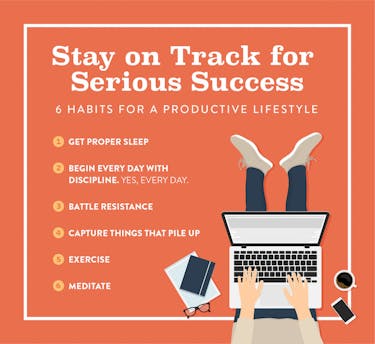
1. Make Sleep Your #1 Priority
Pop culture has got this wrong. When we picture a productive person, we picture someone who consistently sacrifices sleep, diet, and exercise in the name of getting things done.
As it turns out, poor sleep is one of the biggest wrenches you could through into your productivity machine. Sleep affects every aspect of your day.
Sleeping well:
- Increases longevity
- Enhances memory
- Lowers food cravings
- Protects your body from cancer
- Prevents communicable illness
- Lowers your risk of heart attacks, strokes, and diabetes
- Reduces sadness, depression, and anxiety
Sleep affects your learning. Sleeping well energizes your brain to consume information. Sleeping well after learning is what commits that information to long-term memory. It doesn’t matter how much you studied during the day—if you sleep poorly, you won’t recall it later.
“Practice does not make perfect. It is practice, followed by a night of sleep, that leads to perfection.” - Matthew Walker, Why We Sleep
Practice is more effective after good sleep. Habits are built by turning deliberate action into muscle memory. But repeated actions are less likely to turn into habits if the practitioner doesn’t sleep. Your brain needs adequate sleep to build habits into your nervous system.
In his recent book, Matthew Walker advocates for in-office napping and employee benefits for proper sleep. He thinks all companies should adopt nap pods like Nike and Google, and that companies should rewards employees for proper sleep with bonuses or other benefits.
2. Begin Every Day with Discipline. Yes, Every Day.
In his latest book, Jocko Willink states that the key to staying disciplined is waking up early every day—with no exceptions. He believes that waking up with your alarm and NOT hitting “snooze” is an act of discipline that will set the tone for the rest of your day.
Jocko famously wakes up every day at 4:30 AM to do deadlifts, burpees, and squats. He posts a photo almost every morning to let people know he’s serious. People ask him all the time “don’t you take days off and sleep in?”
And he always responds “never.”
Discipline and productivity carry momentum. It’s easier to keep it going then it is to start and stop repeatedly.
In Make Your Bed, Retired US Navy Admiral William H. McRaven poses the idea that making your bed is the first and most important thing you do every day. Why? Because it puts you on a path of discipline for the rest of the day.
These strategies both advocate the importance of starting your day with discipline. When you make a decision to be disciplined, it’s easier to ride that wave throughout the day.
3. Battle Your Own Resistance
If your job requires a high degree of creativity (and I hope it does) you’re battling a unique set of challenges. Generating creative content is an internal struggle—no, more than a struggle. It’s war.
That’s why Steven Pressfield wrote the War of Art, a war journal documenting Pressfield’s own struggles and tactics for consistently working as an independent creative. Who is he battling against? Himself. But not all of himself.
He is at war with a specific part of himself he calls Resistance. Resistance is the part of you that opens Facebook when you have work to do. It’s the part of you that skips going to the gym because you’re too tired. It’s the part that rewards you for avoiding the things you’re afraid of.
For creatives, productivity is 100% about battling Resistance. Pressfield’s solution is simple: be a professional.
Whatever you do, be a professional.
Show up every day, no matter what, and stay on the job all day. Regardless of where or how you work, dress and behave accordingly. Come to work prepared. Small details are good reminders that you are here to work, not to indulge Resistance.
Do not confuse your dream with your hobby. Hobbies keep you entertained, but dreams require relentless devotion.
If you’ve chosen something to do, do it like your life depends on it.
Be consistent in your work. Work with a plan and be patient. Do not wait for inspiration. Accept no excuses.
4. Capture Things That Pile Up
David Allen’s Getting Things Done: The Art of Stress-free Productivity has another great approach for improving productivity. As he explains in his book, when non-immediate problems start piling up, simply create a placeholder for them. Then, work on them when you have the time.
For example, if your mail starts to pile up all over your house, simply get a tray and dump every piece that lands in your mailbox there. Then, go through all of the mail at your convenience and decide what to keep and what to toss.
The good stuff goes in a box to be opened and reviewed, and the rest gets thrown away or recycled.
It sounds simple enough but, think about it—how many times have you been completely stressed because you feel you have to act on every task, every question and every request right in the moment?
Mail is no exception. It comes daily and, often, it feels like we must open it right then and there...or else.
But that’s not reality. Most things can wait. And you’ll stress less knowing your minor tasks are organized.
5. Include Exercise in Your Routine
Fewer than one in four Americans gets the recommended amount of exercise they need. That’s a big problem—for their bodies, their health, and their productivity.
Physical activity fosters discipline. When we work out, we’re more focused. We have more energy. We learn and retain information better.
Working out teaches us the value of hard work and the accompanying joy of progress.
6. Meditate Daily

Like exercise, meditation helps you harness your focus.
Egoless reflective thinking promotes objectivity. It removes the emotion from a situation and allows you to view your successes through a more effective lens.
Get 3% Better Every Month
There it is, the canon of productivity. Maybe that was a little overwhelming. . . You’re probably wondering, how the hell am I supposed to make all of these changes?
Here’s the good news: you don’t have to do everything at once. Trying to build 15 new routines at the same time will certainly end in failure. Start with a single change you want to make, take the time you need to master it, and move on to the next one. Batch your routines if you feel up to it.
If you become even 3% more productive each month, you’ll have a 38% return on your productivity in a year! That’s payday loan interest!
The most productive people are always looking to be better . . . so don’t put too much pressure on yourself out of the gate. Sit back and settle in for the long haul. Make a commitment to keep growing as a truly productive person.
To learn more about productivity, check out these resources referenced throughout the post.
Grit by Angela Duckworth
Checklist Manifesto by Atul Gawande
Why We Sleep by Matthew Walker
War of Art by Steven Pressfield
